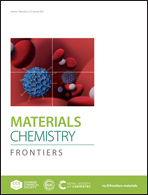Lithiophilic liquid metal layer induced lithium plating/stripping in a 3D Cu matrix to mitigate lithium dendrites and volume expansion†
Abstract
A 3D porous current collector has been considered as an ideal host for a metallic lithium anode to address the challenges of volume expansion. However, lithium tends to deposit on the surface and plug the pores, leading to insufficient pore utilization, dendrite growth and battery safety concerns. Herein, a multi-gradient 3D current collector (MGC), comprising a lithiophilic gradient layer and a conductivity gradient layer, for highly reversible and dense lithium deposition is proposed. The bottom liquid metal (LM) layer serves as a lithiophilic gradient layer, inducing the deposition of lithium from the bottom layer and promotes the homogenization of the lithium flux. The MGC electrode exhibited a highly reversible lithium plating/stripping performance of over 2750 h at 1 mA h cm−2 and over 850 h at 5 mA h cm−2, with a pore utilization efficiency of 88.8% with no dendrite formation. The full cells coupled with LiFePO4 (LFP) cathodes were assembled and delivered an ultra-stable cycle performance of over 2000 times. This study provides a facile approach to achieve a stable current collector for a metallic lithium anode.



 Please wait while we load your content...
Please wait while we load your content...